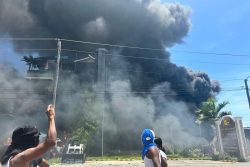One of the surprises of the so-called Arab Spring that has witnessed widespread popular uprising against the most entrenched political regimes in the Middle East, has been the speed with which some of them have collapsed – a matter of weeks in the cases of both the Ben Ali regime in Tunisia and, even more surprisingly, in the case of the Mubarak government in Egypt. Both had ruled for decades and had consolidated their hold on power through the suppression of political opposition. Both were led by men whose military backgrounds had been largely responsible for their rise to power. In the end, though, both regimes fell quickly and with far less loss of life than might have been expected.
In Libya and Syria too, the rise to power by the incumbents was also connected to their military ties; in the case of Syria it was the current President Bashir al Assad’s father and predecessor, Hafeez, whose air force career and influence within the Ba’ath party paved the way for the creation of a regime comprising, in the main, members of al Assad’s minority Alawite tribe. Both regimes have proven more obdurate in the face of popular protest, though in Libya’s case, Colonel Gaddafi’s hold on power now appears more tenuous, undermined as it has been by defections among the regime’s military and political elite and by the military and diplomatic backing which the anti-Gaddafi forces have secured from the West.
The Syrian city of Hama is a historic symbol of the brutality of the al Assad regime. Hama is, too, the most poignant example of resistance to autocratic rule in the Middle East. The city is remembered far beyond the region for the 1982 military siege that left an estimated 30,000 people dead. Prior to the infamous Hama massacre, in fact, shortly after the advent of the Ba’athist regime in Syria in 1964, Hama had come to symbolize the epicentre of popular resistance to state rule. Less than a year after the rise to power by the Ba’athists, troops and tanks were sent to crush the insurgency there.
During the 1970s Hama emerged as the most persistent source of opposition to the al Assad regime and in the process was targeted for several military crackdowns.
The 1982 siege of Hama is still regarded as the single most ruthless regime response to political opposition in the contemporary history of the Middle East. Believed to have been triggered by an attempt on the life of Hafeez al Assad in 1980, the subsequent military campaign culminated in the sacking of the city. Syrian troops under the command of the President’s brother, Riaafat, laid waste to Hama, destroying much of the city. What particularly singled the Hama Massacre out for international attention were the reported atrocities that attended the military attack including the torture, rape and mass executions that formed part of the crackdown. Hama singled out the al Assad government as perhaps the most ruthless regime in the Middle East.
Almost thirty years after being crushed, Hama has risen again, taking its place this time among other cities in a far more serious push for regime change in Syria. While the more widespread popular uprising has now forced the al Assad government into making a hollow concession to the formation of opposition political parties and a promise to hold general elections before the end of 2011 – this, by a government that has never subjected itself to a poll – it persists in its crackdown against Hama. Since June, demonstrations there have been met with further military repression.
The June protest, involving tens of thousands of people was targeted by secret police and military forces in clashes that reportedly killed 50 people. A subsequent three-day strike and an even larger July 1 protest reportedly involving more than 400,000 people was responded to with the sacking of the city’s Governor, deemed to be far too tolerant of the demonstrations, and another military onslaught during which more demonstrators in Hama were killed and women reportedly raped.
A few days later, already frayed relations between Washington and Damascus became ever further strained when the US Ambassador to Syria Robert Ford visited Hama and announced that he would remain there for two days. The American diplomat’s action, seemingly at personal risk, triggered yet another protest, reportedly the largest yet against the Syrian government. During that protest, Ambassador Ford was joined by the French Ambassador.
On Sunday, July 31, Hama was to feel the weight of the Syrian military again when army units stormed the city in an operation that extended itself into the next day, the start of the holy month of Ramadan. Dozens of people were reportedly killed. In recent days more than 100 lives have been lost in Hama.
Aware as the Syrian government is of the symbolism of Hama, it moved last weekend to display television images of destroyed buildings and empty streets in the city as evidence that it had quelled the rebellion before the start of Ramadan. However, the renewed assault on Hama appears to have sparked other demonstrations elsewhere in Syria by protestors voicing their solidarity with Hama. Up to last weekend and despite its promises of elections, the al Assad government was still deploying the military against Hama and other Syrian towns and cities.
The renewed assault on Hama also appears to have triggered a fresh sense of external urgency in relation to events inside Syria. Late last week the United States Congress issued fresh calls for the Obama administration to take action against the Syrian regime. In the region the Gulf Corporation Council bluntly declared that it was concerned over “the escalating violence in Syria and use of excess force” and called for an “immediate end to the violence and any armed appearances, as well as an end to the bloodshed.” In neighbouring Turkey the government said it had “run out of patience” with the al Assad regime and could no longer “remain a spectator” to events across its border. Most surprising of all is the statement issued by King Abdullah of Saudi Arabia, who called for an end to the bloodshed in Syria; he also withdrew his ambassador from Damascus. That statement had been preceded by one from the Arab League, calling on Syria’s leaders to stop the “killing machine.”
Recent events in Hama appears to have had the effect of further galvanizing both internal and external responses to Bashir al Assad’s rule, while the troubled city now appears to be acutely aware of its historical role in Syria’s quest for regime change. For all the official repression, it endures.
Inside Syria, political authority has reportedly shifted from the Ba’ath party through which Hafeez al Assad came to power, directly into the hands of the al Assad family. President Bashir himself is said to be heavily influenced by his hard-line brother Maher and other family members. If this is true the Syrian people will be aware that promises of democratically held elections are, in all likelihood, no more than a ruse to help quell the popular uprising.
Hama, meanwhile, continues both to bear the brunt of the Syrian regime’s brutal response to the popular uprising as well as to symbolize the determination of the Syrian people to bring an end to the rule of the al Assad clan. If Hama has had to pay a high price for its militancy, it may yet play a decisive role in determining the eventual fate of its tormentors.









